Common Name: hydrilla
Family: Hydrocharitaceae
Common Synonyms: none
USDA Hardiness Zone: 5a-11
Growth Habit: Aquatic perennial herb
Origin: Warmer regions of the Old World
FISC Category: 1
FDACS Listed Noxious Weed: Yes
Introduction Date: 1960
IFAS Assessment:


Aquatic, submersed, perennial herb with slender stems to 9 m long, many branched. Stems from rhizomes. Whorled leaves, 3-8 per whorl, with toothed margins, and 1-4 conical bumps on the underside of the midrib. Fleshy buds form in the leaf axils called turions, each with 3 sepals and petals, whitish and floating.
Lakes, rivers
Similar to Egeria densa, also a non-native invasive, which has whorls of 3-6 leaves and no conical bump on midrib.

Note: Timing and herbicide concentration are important to consider in terms of efficacy and non-target damage to native species (IFAS).
Dave's Garden. 2014. PlantFiles: Hydrilla, Hydrilla verticillata. http://davesgarden.com/guides/pf/go/32040/. Accessed on June 20, 2014.
IFAS, Center for Aquatic & Invasive Plants. 2014. Plant Management in Florida Waters: An Integrated Approach. http://plants.ifas.ufl.edu/manage/control-methods/chemical-control/selective-application-of-aquatic-herbicides. Accessed on June 25, 2014.
Langeland, K.A., H.M. Cherry, C.M. McCormick, K.C. Burks. 2008. Identification and Biology of Non-Native Plants in Florida's Natural Areas-Second Edition. IFAS Publication SP 257. University of Florida, Gainesville, Florida.
Texas A&M, AgriLife Extension. 2014. AQUAPLANT, A pond manager diagnostic tool: Hydrilla. http://aquaplant.tamu.edu/management-options/hydrilla/. Accessed on June 25, 2014